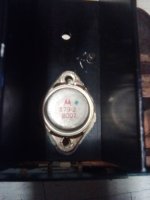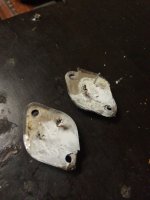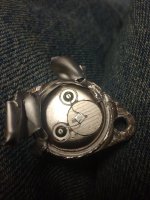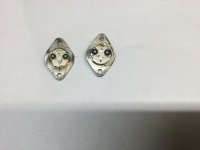Aaron, welcome to the forum.
This is probably a Motorola in-house transistor.
In what amplifier(?) did you find it?
Hugo
This is probably a Motorola in-house transistor.
In what amplifier(?) did you find it?
Hugo
No I wasn't able to find a datasheet or info on this transistor. And no I don't know what kinda radio/amp this is. I was gonna take the transistors and make a homemade amp.

Last edited by a moderator:
According to this forum, a few members point to a NTE130 that lists the 179-2 as a 179N2 and is just a 2N3055.
Hope this helps.
https://www.yoreparo.com/es/electronica-antigua/preguntas/6050140/duda-con-transistor
Hugo
Hope this helps.
https://www.yoreparo.com/es/electronica-antigua/preguntas/6050140/duda-con-transistor
Hugo
I’ve run into them before in the early years, and just put in 2N3055s. Never seen one run on more than 60 volts, so I figured it was pretty safe.
Motorola was notorious for putting their own numbers on common parts. Same with ICs. MC140xx is just a plain 40xx-series logic chip.
Tom
Tom
Often those house numbers are selected for hFE range (like the letter grades on the Jap parts) so the manufacturer can better match, or if they want the top of the range. Sometimes they are selected for voltage, such as 2N3773’s that will run at 200V (Peavey’s SJ6343). The problem with all this is that any such testing is done under NDA, and they do honor those agreements which means WE can’t get at the data. Stuff like Peavey and early Crown got out because both were very free with their service info and PUBILISHED their cross references.
Usually you just have to figure out what the circuit needs and use an appropriate part. Fortunately today if you run into an unknown TO-3 most of what ON offers is miles ahead of the original, even if the selection is limited to 2 or 3 parts.
Usually you just have to figure out what the circuit needs and use an appropriate part. Fortunately today if you run into an unknown TO-3 most of what ON offers is miles ahead of the original, even if the selection is limited to 2 or 3 parts.
The semiconductor is a Motorola TO3 is a “House Number”. By the code date (1980 7 week), I would suspect a NPN 2N3055. @ BGW I used many standard parts with special selected parameters. Some were Beta selection, Beta graded, Vceo & other. If you have the schematic a good EE should be able to cross reference a part.
Duke
Duke
If your going to be working with amps a lot then I would suggest a transistor tester.
They will tell you connections, channel type, Hfe, etc etc
They will tell you connections, channel type, Hfe, etc etc
Well got two of the transistors out and there is one leg on each of them that spins I don't think the legs suppose to do that maybe the next two will be better I'm learning at them moment and having fun making little things and seeing them work really Hugo thanks for the help I been a slow learner all my life still don't really know how a transistor works
Attachments
If the leg spins the glass blob that holds it in place is broken, so the hermetic seal has gone - the bond wire has likely snapped too.
Ya my friend that I got it off of thought he could repair it himself I told him if he had left it alone I might have been able to do something with it. While I wait to see what he is gonna do I'm trying to make a Bluetooth speaker for a person using this chip TA8210AH like I said I'm still learning so learning everything I can about it first before I start making a circuit
If one of them is no good take a file and a pair of needle nose, and open it up (pull off the top hat). We’d all like to see if it “looks“ like a 2N3055.
I'm just finding resistors right now and different components gonna try the test is the data sheet for this next chip I'm working on
- Home
- Design & Build
- Parts
- Need help finding info for transistor



